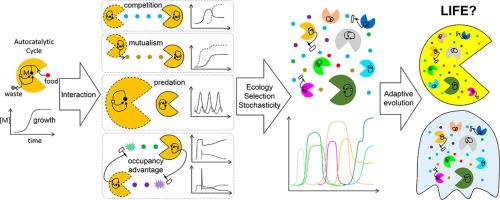Journal of Theoretical Biology ( IF 2 ) Pub Date : 2020-08-12 , DOI: 10.1016/j.jtbi.2020.110451 Zhen Peng 1 , Alex M Plum 2 , Praful Gagrani 3 , David A Baum 4

|
It is becoming widely accepted that very early in life’s origin, even before the emergence of genetic encoding, reaction networks of diverse small chemicals might have manifested key properties of life, namely self-propagation and adaptive evolution. To explore this possibility, we formalize the dynamics of chemical reaction networks within the framework of chemical ecosystem ecology. To capture the idea that life-like chemical systems are maintained out of equilibrium by fluxes of energy-rich food chemicals, we model chemical ecosystems in well-mixed containers that are subject to constant dilution by a solution with a fixed concentration of input chemicals. Modelling all chemical reactions as fully reversible, we show that seeding an autocatalytic cycle with tiny amounts of one or more of its member chemicals results in logistic growth of all member chemicals in the cycle. This finding justifies drawing an instructive analogy between an autocatalytic cycle and the population of a biological species. We extend this finding to show that pairs of autocatalytic cycles can show competitive, predator-prey, or mutualistic associations just like biological species. Furthermore, when there is stochasticity in the environment, particularly in the seeding of autocatalytic cycles, chemical ecosystems can show complex dynamics that can resemble evolution. The evolutionary character is especially clear when the network architecture results in ecological precedence, which makes a system’s trajectory historically contingent on the order in which cycles are seeded. For all its simplicity, the framework developed here helps explain the onset of adaptive evolution in prebiotic chemical reaction networks, and can shed light on the origin of key biological attributes such as thermodynamic irreversibility and genetic encoding.
中文翻译:

用于分析益生元化学反应网络的生态框架。
人们普遍认为,在生命起源的早期,甚至在遗传编码出现之前,各种小化学物质的反应网络可能已经表现出生命的关键特性,即自我繁殖和适应性进化。为了探索这种可能性,我们在化学生态系统生态学框架内将化学反应网络的动力学形式化。为了捕捉到生命般的化学系统因富含能量的食品化学品的流动而失去平衡这一想法,我们在混合良好的容器中模拟化学生态系统,这些容器会被具有固定浓度输入化学品的溶液不断稀释。将所有化学反应建模为完全可逆的,我们表明,用少量的一种或多种成员化学品播种自催化循环会导致循环中所有成员化学品的物流增长。这一发现证明了在自催化循环和生物物种种群之间进行有启发性的类比是合理的。我们扩展了这一发现,以表明成对的自催化循环可以像生物物种一样显示出竞争性、捕食者-猎物或共生关联。此外,当环境中存在随机性时,特别是在自催化循环的播种中,化学生态系统可以表现出类似于进化的复杂动态。当网络架构导致生态优先时,进化特征尤其明显,这使得系统的轨迹在历史上取决于循环播种的顺序。



























 京公网安备 11010802027423号
京公网安备 11010802027423号